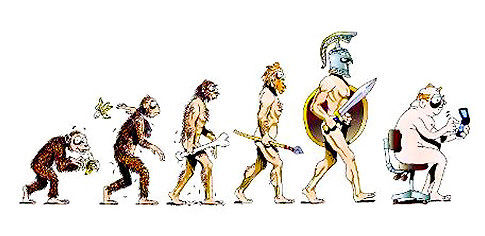
I’m reading Nexus, by Ramez Naam. I like the book so far, except for the early chapters, which are a little creepy and repetitive. But one of the themes is that there will be a war between transhumans and unaugmented humans. This idea has gained popularity and it’s starting to annoy me.
When I saw Ramez Naam speak at the H+ conference in 2012, he scoffed at the very term “transhuman.” He made the point that ALL humans augment, and the term “transhuman” seems to imply a mythical, non-augmenting human. His examples of transhumans were people who have pacemakers or who use birth control. Look at professional athletes. Does anyone really think those are unaugmented humans? They’re on steroids, practically mutants. Cyclists are using blood doping until their blood is so packed with red blood cells that it sometimes stops flowing through their veins and kills them. Or consider how new prosthetic legs make amputee runners superhuman.
I would go so far as to say that using a sharpened stick is as transhuman as using a brain-computer interface. So transhumanism is a misnomer. Transhumanism is really just extreme tool use. And politics being what they are, the elite will always control the wielders of technology, just as kings controlled the knights of medieval times.
But writers keep setting up conflicts between tool users and non-tool users. Zoltan Istvan has previously called for transhumans to deliberately create conflicts with religious people, who he imagines don’t like tools. Yuval Harari in Homo Deus suggests that transhumans could dominate humans as 19th century Europeans dominated Africans. In a recent Forbes article, Jeff Stibel warns that brain-computer interfaces could destroy humanity and calls for ethicists and philosophers to guide us. And, you know what, they are all correct (aside from the ethicists guiding us idea, that’s utterly laughable bullshit), but they are missing a key point.
Tool using populations destroy non-tool using populations. In the past, farmers used crazy technology to create food on demand and then consolidated resources and crushed the hunter-gatherers around them. Zoltan needn’t call for deliberate conflict. The wielders of the most advanced technology INEVITABLY overwhelm or convert those without it. Transhumanism will be no different. Harari might take a moment to note how the technology rich Global North dominates the poor Global South TODAY. Wealthy Westerners are already transhuman compared to the poorest in the world. We have longer lives and amazing influence.
This competition is very essentially human, and I’m not even sure that it’s entirely bad. As I’ve said before, cooperative groups turn out to be more competitive. Compassion is an evolved superweapon. Stibel is deluded. There is no stopping this process. He can hold back his patents for BrainGate all he wants. The physical world will continually yield up its mechanisms of action to the prying minds of restless humans. His discoveries will be reproduced. Cultures that seek to repress technology will be surpassed and dominated by cultures that don’t. That’s just the way the world works. Partly because ethics aren’t universal. Some players have legitimately diverging interests.
But in the broader scheme of things, we aren’t meant to stop and rest. Life has been evolving for billions of years. It will keep evolving. That’s physics. Entropy must be maximized and the negative entropy of more and more complex living things must fulfill the requirement of the physics engine running our universe. What if life had stopped evolving at bacteria? From a human’s perspective, that would have sucked. How can we begrudge the post-humans their place? Hint, we don’t get to. On the plus side, bacteria ARE still around and we need them to survive. On the negative side, neanderthals only exist as DNA remnants. I hope that the jump to the next level of evolution will be so extreme that, to the next generation, humans are more like bacteria and less like neanderthals. There’s a strange toast. Cheers!


